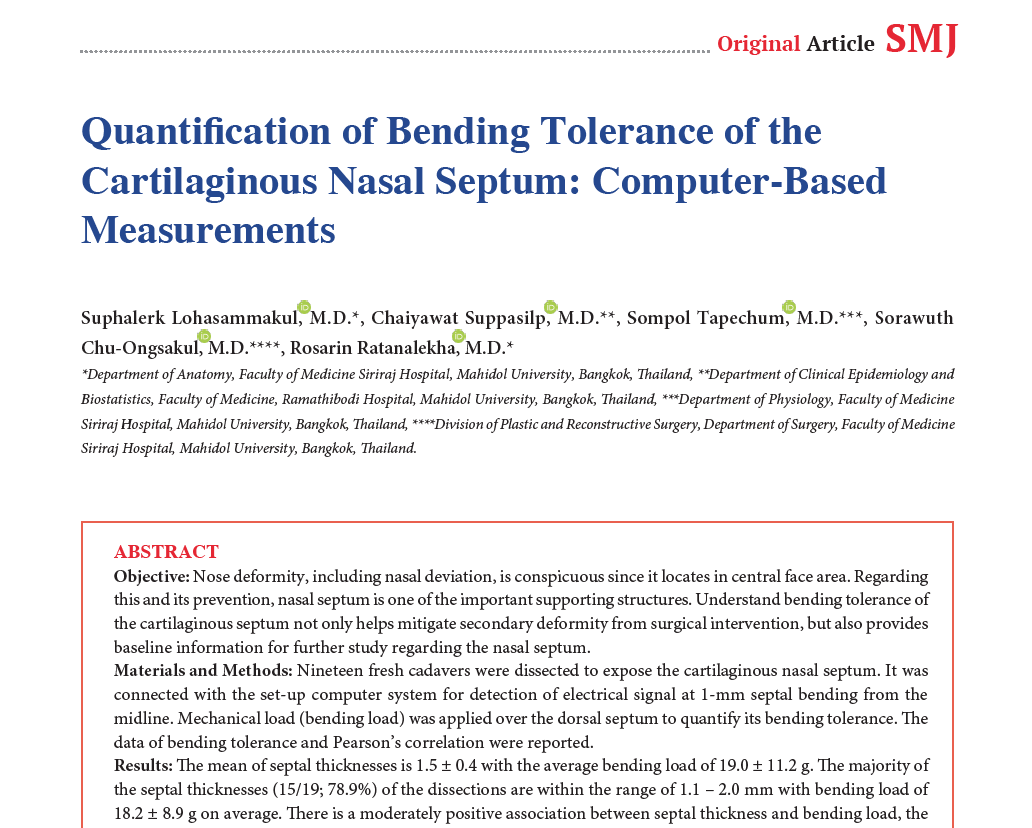Quantification of Bending Tolerance of the Cartilaginous Nasal Septum: Computer-Based Measurements
DOI:
https://doi.org/10.33192/Smj.2022.51Keywords:
Nasal septum, nasal deformity, bending tolerance, mechanical load, quantificationAbstract
Objective: Nose deformity, including nasal deviation, is conspicuous since it locates in central face area. Regarding this and its prevention, nasal septum is one of the important supporting structures. Understand bending tolerance of the cartilaginous septum not only helps mitigate secondary deformity from surgical intervention, but also provides baseline information for further study regarding the nasal septum.
Materials and Methods: Nineteen fresh cadavers were dissected to expose the cartilaginous nasal septum. It was connected with the set-up computer system for detection of electrical signal at 1-mm septal bending from the midline. Mechanical load (bending load) was applied over the dorsal septum to quantify its bending tolerance. The data of bending tolerance and Pearson’s correlation were reported.
Results: The mean of septal thicknesses is 1.5 ± 0.4 with the average bending load of 19.0 ± 11.2 g. The majority of the septal thicknesses (15/19; 78.9%) of the dissections are within the range of 1.1 – 2.0 mm with bending load of 18.2 ± 8.9 g on average. There is a moderately positive association between septal thickness and bending load, the Pearson’s correlation coefficient is 0.602 (95%CI from 0.204 to 0.830) with p-value of 0.006.
Conclusion: The overall nasal septum and the septum with thickness between 1.1 – 2 mm are able to tolerate loading over distal part of caudal septum about 19.0 and 18.2 g, respectively. Septal thickness shows moderately positive correlation with bending load.
References
FJ M. Aesthetic nasal reconstruction. In: Rodriguez ED LJ, Neligan PC, editor. Plastic surgery 4th ed Vol 3, Craniofacial, head and neck surgery and pediatric plastic surgery. Philadelphia: Elsevier; 2018. p. 126-80.e2.
Kridel RW, Scott BA, Foda HM. The tongue-in-groove technique in septorhinoplasty. A 10-year experience. Arch Facial Plast Surg. 1999;1(4):246-56; discussion 57-8.
Toriumi DM. Structure approach in rhinoplasty. Facial Plast Surg Clin North Am. 2005;13(1):93-113.
Ha RY, Byrd HS. Septal extension grafts revisited: 6-year experience in controlling nasal tip projection and shape. Plast Reconstr Surg. 2003;112(7):1929-35.
Pham AM, Tollefson TT. Correction of caudal septal deviation: use of a caudal septal extension graft. Ear Nose Throat J. 2007;86(3):142, 144.
Sancho BV, Molina AR. Use of septal cartilage homografts in rhinoplasty. Aesthetic Plast Surg. 2000;24(5):357-63.
Yoon SH, Kim CS, Oh JW, Lee KC. Optimal harvest and efficient use of septal cartilage in rhinoplasty. Arch Craniofac Surg. 2021;22(1):11-6.
Yanagisawa E, Ho SY. Unintended middle turbinectomy during septoplasty. Ear Nose Throat J. 1998;77(5):368-9.
Yeo NK, Jang YJ. Rhinoplasty to correct nasal deformities in postseptoplasty patients. Am J Rhinol Allergy. 2009;23(5):540-5.
Ketcham AS, Han JK. Complications and management of septoplasty. Otolaryngol Clin North Am. 2010;43(4):897-904.
Planas J. The twisted nose. Clin Plast Surg. 1977;4(1):55-67.
Moche JA, Palmer O. Surgical management of nasal obstruction. Oral Maxillofac Surg Clin North Am. 2012;24(2):229-37, viii.
Kim DW, Gurney T. Management of naso-septal L-strut deformities. Facial Plast Surg. 2006;22(1):9-27.
Gubisch W. The extracorporeal septum plasty: a technique to correct difficult nasal deformities. Plast Reconstr Surg. 1995;95(4):672-82.
Gubisch W. Twenty-five years experience with extracorporeal septoplasty. Facial Plast Surg. 2006;22(4):230-9.
King ED, Ashley FL. The correction of the internally and externally deviated nose. Plast Reconstr Surg (1946). 1952;10(2):116-20.
Toriumi DM. New concepts in nasal tip contouring. Arch Facial Plast Surg. 2006;8(3):156-85.
Beaty MM, Dyer WK, 2nd, Shawl MW. The quantification of surgical changes in nasal tip support. Arch Facial Plast Surg. 2002;4(2):82-91.
Assanasen P, Jareoncharsri P, Bunnag C. The Relationship between deviated nasal septum and middle ear pressure. Siriraj Med J. 2002;54(8):439-54.

Published
How to Cite
Issue
Section
License

This work is licensed under a Creative Commons Attribution-NonCommercial-NoDerivatives 4.0 International License.
Authors who publish with this journal agree to the following conditions:
Copyright Transfer
In submitting a manuscript, the authors acknowledge that the work will become the copyrighted property of Siriraj Medical Journal upon publication.
License
Articles are licensed under a Creative Commons Attribution-NonCommercial-NoDerivatives 4.0 International License (CC BY-NC-ND 4.0). This license allows for the sharing of the work for non-commercial purposes with proper attribution to the authors and the journal. However, it does not permit modifications or the creation of derivative works.
Sharing and Access
Authors are encouraged to share their article on their personal or institutional websites and through other non-commercial platforms. Doing so can increase readership and citations.














